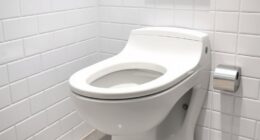I’ve had my fair share of frustrating moments with a running toilet. You know the feeling – the constant sound of water, the wasted gallons, and the sinking feeling that your water bill is about to skyrocket.
But fear not, because in this article, I’ll show you how to put an end to this annoying problem. By understanding the causes and taking a few simple steps, you’ll be able to fix that running toilet and save yourself from the headache and the expense.
Key Takeaways
- The most common causes of a running toilet include a faulty flapper valve, high float level, worn-out flush valve, and faulty fill valve.
- To check and adjust the fill valve, locate it, turn off the water supply, flush the toilet to drain the water, loosen the lock nut on top of the fill valve, adjust the water level, and tighten the lock nut.
- Inspect the flapper valve for leaks and use food coloring to detect leaks. Turn off the water supply, flush the toilet, remove the old flapper, attach a new one, and ensure it creates a tight seal.
- Understand different valve replacement options, be aware of common flush valve issues, consider DIY troubleshooting tips before calling a plumber, and replace the flush valve if necessary. Follow the steps for valve replacement.
Understanding the Causes of a Running Toilet
Understanding the causes of a running toilet can help you troubleshoot and fix the issue quickly. When it comes to a running toilet, the main culprits are usually found in the toilet tank and the toilet bowl.
In the toilet tank, the most common cause of a running toilet is a faulty flapper valve. This valve controls the flow of water from the tank into the bowl, and if it is not sealing properly, water will continue to leak into the bowl, causing it to constantly fill. Another potential issue in the tank is a float that is set too high, causing the water level to rise above the overflow tube and continuously flow into the bowl.
In the toilet bowl, a running toilet can be caused by a worn-out flush valve or a faulty fill valve. The flush valve is responsible for releasing water from the tank into the bowl during a flush, and if it is not closing properly, water will continue to flow. Similarly, a faulty fill valve can cause water to continuously enter the bowl, even when it is not being flushed.
Checking and Adjusting the Fill Valve
To fix the issue, you should first check and adjust the fill valve in your toilet. The fill valve is responsible for regulating the water level in the tank. If it is not adjusted correctly, it can cause your toilet to constantly run or overflow.
Start by locating the fill valve, which is usually on the left side of the tank. Turn off the water supply to the toilet by closing the shut-off valve.
Next, remove the tank lid and flush the toilet to drain the water. Use an adjustable wrench to loosen the lock nut on top of the fill valve. Turn the adjustment screw clockwise to lower the water level or counterclockwise to raise it.
Once you have adjusted the water level, tighten the lock nut and turn the water supply back on. If adjusting the fill valve doesn’t solve the issue, you may need to replace it altogether.
Inspecting and Fixing a Flapper Valve
First, take a look at the flapper valve to inspect and fix any issues. The flapper valve is responsible for sealing the flush valve and preventing water from constantly flowing into the toilet bowl. To diagnose leaks, place a few drops of food coloring into the tank and wait for about 15 minutes. If the coloring seeps into the bowl, it indicates a leaky flapper valve.
To replace the flapper, turn off the water supply to the toilet and flush to drain the tank. Remove the old flapper by disconnecting it from the flush chain and then attach the new flapper. Make sure it creates a tight seal when closed. This will ensure that water doesn’t continuously flow into the toilet bowl, thus stopping the running toilet.
Now, let’s move on to repairing a faulty flush valve.
Repairing a Faulty Flush Valve
When it comes to repairing a faulty flush valve, there are several key points to consider.
First, it’s important to understand the different valve replacement options available. From traditional flapper valves to newer dual flush valves, each option has its own advantages and disadvantages.
Second, it’s helpful to be aware of common flush valve issues that may arise, such as leaks or incomplete flushing.
Lastly, DIY troubleshooting tips can be a cost-effective and efficient way to tackle minor flush valve problems on your own before calling in a professional plumber.
Valve Replacement Options
One option for valve replacement is using a flapper valve. Flapper valves are commonly used in toilet systems and are relatively easy to install. They help regulate the water flow and prevent any leaks or running toilets. Flapper valves can be purchased at any hardware store and come with instructions for installation. To troubleshoot water flow issues, it is important to check the valve for any signs of damage or wear. If the valve is faulty, it may need to be replaced. Here is a table outlining the steps for replacing a flapper valve:
| Step | Description |
|---|---|
| 1 | Turn off the water supply to the toilet |
| 2 | Remove the old flapper valve |
| 3 | Install the new flapper valve |
| 4 | Turn on the water supply and test for proper functioning |
Common Flush Valve Issues
To address common flush valve issues, you may need to check for any signs of damage or wear on the valve. Flush valve maintenance is crucial to ensure proper functioning of your toilet.
One common issue you may encounter is an overflow. If your toilet is constantly running or the water level is too high, it could be due to a faulty flush valve. Start by inspecting the valve for any cracks, leaks, or buildup of mineral deposits. If you notice any of these issues, it may be necessary to replace the flush valve.
Troubleshooting overflow issues can be a simple fix with proper maintenance and attention to detail.
Now, let’s move on to some DIY troubleshooting tips to help you resolve these problems on your own.
DIY Troubleshooting Tips?
Now that we’ve covered common flush valve issues, let’s dive into some DIY troubleshooting tips that can help you resolve these problems on your own.
If you’re experiencing a running toilet, there are a few simple steps you can take to fix it. First, check the flapper valve. If it’s not sealing properly, it may be causing the water to continuously run. Adjust or replace the flapper if necessary.
Next, check the water level in the tank. If it’s too high, adjust the float to lower it. Another common issue is a faulty fill valve. If you hear a hissing sound, it may need to be replaced.
Finally, check for any leaks or cracks in the toilet tank or bowl. Use dye tablets to identify any leaks and repair them accordingly.
Addressing Issues With the Float Assembly
First, check if the float assembly is properly adjusted and not causing the running toilet. The float assembly is an essential component of a toilet’s flushing mechanism, and if it’s not functioning correctly, it can lead to a continuously running toilet.
To maintain the float assembly, start by inspecting the water level in the tank. If it’s too high or too low, adjust the float arm or the float ball accordingly. Make sure the float is not rubbing against the tank walls or any other parts. Additionally, check for any damage or wear on the float assembly components. If you notice any issues, replace them as necessary.
Troubleshooting float issues involves ensuring the float is free from debris and that the fill valve is working properly. By regularly maintaining and troubleshooting the float assembly, you can effectively stop a running toilet.
Clearing Blockages in the Toilet Bowl
Check if there is any blockage in the toilet bowl by using a plunger or a toilet auger.
If you choose to use a plunger, follow these steps for effective unclogging:
- Position the plunger over the drain hole in the toilet bowl, ensuring a tight seal.
- Apply firm, downward pressure on the plunger to create suction.
- Push and pull the plunger vigorously, repeating this motion several times.
- Release the plunger and check if the water level in the bowl starts to drain. If not, repeat the process.
Using a plunger effectively can often dislodge the blockage and restore proper flushing. However, if the plunger doesn’t solve the issue, you may need to consider using a toilet auger or seeking professional plumbing assistance.
To prevent future running toilet problems, it’s essential to address toilet blockage prevention.
Preventing Future Running Toilet Problems
To avoid future issues with your toilet, it’s important to take preventive measures.
One of the most common maintenance practices is to regularly check for any leaks or drips in and around your toilet. These can lead to a running toilet and wasted water.
Another important step is to ensure proper water pressure. High water pressure can cause damage to the internal components of your toilet, leading to leaks and constant running. You can install a pressure regulator to control the water pressure and prevent any potential issues.
Additionally, it’s recommended to avoid flushing any non-flushable items down the toilet, as they can clog the pipes and cause a running toilet.
Frequently Asked Questions
How Do I Fix a Leaking Water Supply Line?
To fix a leaking water supply line, first turn off the water supply. Then, inspect the line for any visible damage or loose connections. If you find any, tighten or replace the fittings as needed. Finally, turn the water supply back on and check for leaks.
What Should I Do if My Toilet Keeps Running Even After I’ve Replaced the Flapper Valve?
When my toilet keeps running after I replace the flapper valve, I troubleshoot the toilet flush mechanism. I check the fill valve, adjust the water level, and ensure the chain is properly connected.
Can a Running Toilet Cause High Water Bills?
Yes, a running toilet can cause high water bills. It’s important to detect a running toilet by listening for water flowing or placing dye tablets in the tank. It can also damage the plumbing if left unchecked.
Is It Normal for the Water Level in the Toilet Tank to Fluctuate?
Yes, it is normal for the water level in the toilet tank to fluctuate. However, if you notice significant changes, it may indicate a problem. Regular water level maintenance and troubleshooting the toilet tank can help prevent issues.
How Often Should I Clean or Replace the Fill Valve in My Toilet?
The cleaning frequency of the fill valve in my toilet depends on water quality. Signs of a faulty fill valve include constant running water and low water levels. Regular cleaning or replacement ensures proper functioning.
Conclusion
In conclusion, we must remember that a running toilet is like a leaky faucet in our lives. Just as a constant drip wastes water, a running toilet wastes our precious resources.
But fear not, for with a little knowledge and some basic tools, we can fix this issue and restore balance to our bathrooms. By understanding the causes and taking the necessary steps to address them, we can put an end to the endless cycle of wasted water and ensure a more sustainable future.
Remember, even the smallest actions can make a big difference.










